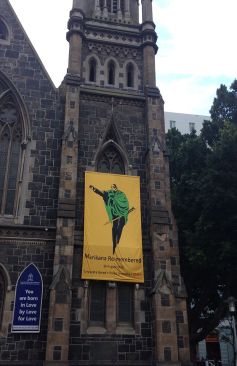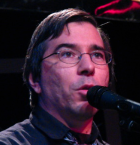Remembering the Marikana Massacre on the Third Anniversary
By Pete Dolack
Published on September 8, 2015

Activists gathered across South Africa, London, New York and Oakland, to commemorate the third anniversary of the Marikana massacre, the deadliest South African massacre since Soweto.
A deadly massacre under an African National Congress government. And not the only shooting of workers, merely the worst under the harsh neoliberal assault overseen by the ANC.
South Africa’s apartheid system was overthrown in a negotiated process forced by a massive international popular movement backing the ANC, but the party has turned its back on popular forces. (This and the next two paragraphs based in part on The Shock Doctrine: The Rise of Disaster Capitalism by Naomi Klein.) During the long years of struggle by the ANC which were accompanied by pitiless repression by the National Party, (the apartheid-era rulers in South Africa), the guiding document of the ANC was its “Freedom Charter.” The charter, adopted after democratic consultations in 1955, calls for the right to work, to decent housing, freedom of thought, nationalization of mines, banks and “monopoly industry”; and land distribution so that all South Africans can share in the wealth of their country.
Although the ANC had the moral authority to carry out its program, its negotiators tragically (and unwittingly) gave up all economic control, forfeiting their ability to carry out any aspect of their program. Within the next two decades this resulted in the economy being firmly in the hands of its numerically minuscule White business elite (which is tied to international markets). The country’s eyes were on the political talks between Nelson Mandela and F.W. de Klerk, in which the ANC decisively was the victor against the National Party’s attempts to dilute its loss of government control.
But in the parallel economic talks, which drew little attention, the ANC gave away everything. The central bank would be independent of government (as financiers demanded), National Party government finance officials would remain in office and the ANC government would sign on to everything demanded by the World Bank, the International Monetary Fund and all international trade agreements. Having done so, the ANC took office handcuffed, and having tied themselves to financial markets, those markets applied further discipline by attacking the South African economy at the first sign of anything that displeased them. From pleasing markets and giving financiers repeated assurances, it proved a short path to President Mandela’s successor, Thabo Mbeki, imposing austerity — a 180-degree turn from the Freedom Charter.
Workers face attacks by management and unions
Mining is a critical component of the South African economy, and the foreign multi-national corporations that own South Africa’s mines mistreat local workers with impunity. (This and the next paragraphs are based on Southern Insurgency: The Coming of the Global Working Class by Immanuel Ness.) Workers are often housed in substandard lodgings which lack water and electricity, and an increasing number of miners are hired as contingent workers. Not only do mine workers not receive support from the National Union of Mineworkers, the NUM actively joins with managements in oppressing its rank and file.
Nor do they receive support from the country’s largest labor federation, the Congress of South African Trade Unions (COSATU) — in February 2012, NUM and COSATU declared a strike by mineworkers illegal and actually took a harder line against the workers than the mine owner did! Mineworkers continued to bypass the union, or organize through an independent grassroots organization, Amcu, as mineworkers pressed to raise their monthly minimum wage from about US$400 to US$1,150. Two workers were shot by snipers on August 11, and the next day, fearful of returning to the mine, workers gathered on a nearby hill.
The management of the company that owned the mine, Lonmin PLC, called in the police. Lonmin sought to have the strike declared illegal and demanded workers surrender the crude weapons they had fashioned to defend themselves. NUM drove a vehicle equipped with a loudspeaker through the nearby settlements, declaring the strike illegal. Workers gathered on the hill again on the morning of August 16 and were encircled by armed police. At 4 p.m., police opened fire, killing 16 workers as television cameras recorded and another 18 were executed off camera after fleeing the initial killings. Another 78 were injured.
An investigation headed by Judge Ian Farlam, appointed by President Jacob Zuma, found that police anticipated the killings hours earlier. Professor Ness, in Southern Insurgency (to be published by Pluto Books in October) provided this summary of the preparation:
“On the morning of August 16, more than eight hours in advance of the police shootings, aware the dozens of workers might be killed in a police assault, Colonels Klassen and Madoda of the [South African Police Service] ordered four mortuary vehicles to the scene from the health department, each with a capacity to carry eight bodies. The report also implicated senior government officials, including ANC and former NUM general secretary Cyril Ramaphosa, a shareholder and director of Lonmin as the events leading up to the Marikana massacre were unfolding. … [A]n email from Ramaphosa to Albert Jamieson, Lonmin’s chief commercial officer, written one day before the massacre and concluding the strike was not a labor dispute but a ‘criminal’ action that required ‘concomitant action.’: ‘The terrible events that have unfolded cannot be described as a labour dispute. They pare plainly dastardly criminal and must be characterised as such. There needs to be concomitant action to address this situation.’ ” Nonetheless, the commission pinned the blame for the massacre on the workers:
“[T]he tragic events that occurred during the period 12 to 16 August 2012 originated from the decision and conduct of the strikers in embarking on an unprotected strike and in enforcing the strike by violence and intimidation, using dangerous weapons for the purpose.”
Pushing back against government whitewash
The Marikana Support Committee, in rejecting that conclusion, declares:
“This statement is offered as a fact that we have to accept. But it is an opinion. There is no evidence to back it up. The Marikana Support Campaign considers this finding as a gross defamation of the miners. At the same time, despite a run of evidence to the contrary, Farlam and his Commissioners exonerate Ramaphosa and other government ministers. Lonmin is substantially exonerated.”
The Support Committee is calling for a new probe, “a civil society-led inquiry based on the evidence.”
The National Union of Metalworkers of South African (NUMSA), a union expelled from the COSATU trade-union federation after challenging the federation to break with the ANC and the ANC’s neoliberal policies, also sided with the mineworkers. In a statement issued for the third anniversary of the Marikana massacre, the metalworkers union said:
“The Marikana Massacre in 2012 signified the degeneration of our country into a Police State, as evidenced by the continued usage of police and excessive force to undermine popular dissent from below. … The mining industry, like many other key sectors of our economy for many years have been heavily dependent on Black and African working class cheap labour, for its profit maximisation and wealth accumulation strategy. … It is our view that the Marikana Report that was released to the public by President Jacob Zuma was a spit on the face of Marikana’s widows and victims’ families, since it was a whitewash and was intended to make the fast fading ANC-government look caring in the eyes of the working class.”
After two decades of ANC governance, South Africa is the most unequal country on Earth. The country’s gini co-efficient, the most common measure of inequality, was the world’s highest at 0.65 in 2011, according to World Bank statistics, and it is unlikely that this number has improved since. About 57 percent of South Africans live in poverty, and unemployment is 26.4 percent at the same time that only 80 percent of industrial capacity is being utilized.
It is not only divisions along racial, national and gender lines that divide us and block necessary solidarity, it is also the North-South division. An injury to one is an injury to all, regardless of where.
The Author

Pete Dolack is an activist and writer who currently analyzes the ongoing economic crisis, and the political and environmental issues connected to it, on the Systemic Disorder blog. He has been active with several groups, currently with TradeJustice New York Metro.
He is the author of the book It’s Not Over: Lessons from the Socialist Experiment, an analysis of the 20th century’s attempts to create alternatives to capitalism that proposes to draw lessons for emerging and future movements seeking answers to the political and economic crises of today, due to be published by Zero Books in late 2015.
Article picture: Church on Green Market Square in Cape Town, South Africa with a banner commemorating the Marikana massacre. Source: Wikipedia. Author: Discott


